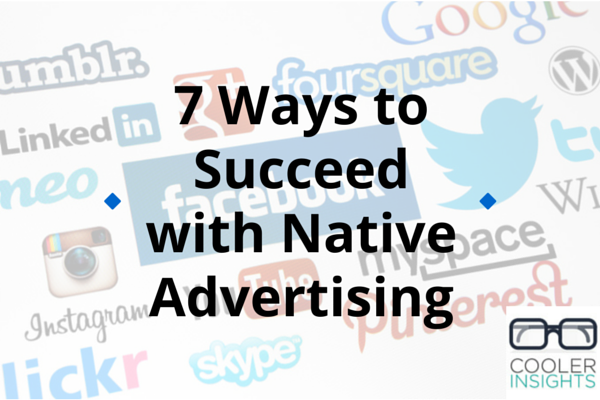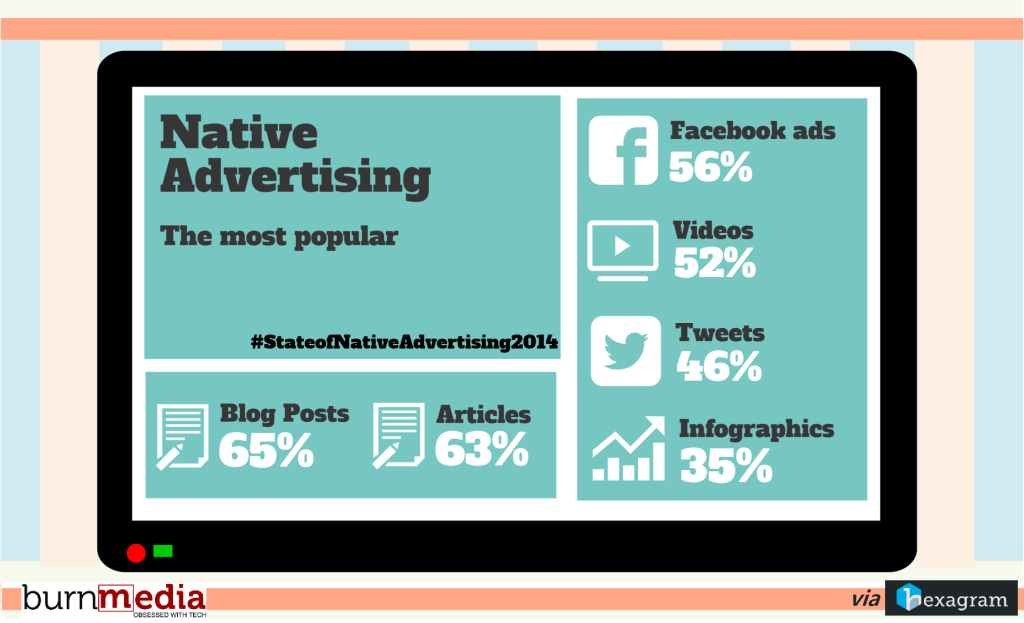Have you started “going native” in your marketing strategy? If you haven’t, its high time you do.
Traditionally known as advertorials or sponsored content, native advertising is a form of online advertising where the content matches the form and function of the channel in which it appears. These ads can either by created by the advertising company, an agency, or the media owner.
In the years ahead, it is forecasted that native ads will only grow.
Social and digital media platforms like Facebook, Twitter, and Yahoo! are already pushing hard to capture a larger share of the digital advertising pie by offering native advertising options.
They are joined by the myriad owners of traditional news and magazine websites looking to monetize their online presences.
Why Native Advertising?
A hybrid of content marketing and influencer marketing, native advertising is rocking the boats of traditional advertisers and agencies alike.
Many marketers are bullish about native advertising. Just look at this projections of its growth in the US alone!
Courtesy of Business Insider
According to an article in Shareholic, native ads outperform more traditional forms of banner or display advertising. Consider the following:
- People view native ads 53% more than banner ads.
- 70% of individuals prefer to learn about products through content rather than traditional advertising.
- A native advertising campaign for GE reached 5.1 million people and resulted in 416,000 clickthroughs — an astronomical >8% CTR. Compare that to traditional display ad CTRs, which have dropped from 9% in 2000 to 0.2% in 2012.
- 32% of consumers said they would share a native ad with friends and family vs 19% for banner ads.
- Viewers spend nearly the same amount of time reading editorial content and native ads — 1.2 seconds and 1 second, respectively.
- Native advertising generates up to an 82% increase in brand lift.
- Native ads that include rich media boost conversion rates by up to 60%.
- Purchase intent is 53% higher with native ads.
It certainly looks like native ads are making their impact felt. And the forecast looks rosy – beginning with the US where it has taken off in a big way.
Harnessing the Power of Native Ads
With the impending death of traditional display ads, the thorny question arises: How can you remodel your marketing organisation to take advantage of native ads?
Here are seven steps you need to take when embarking on your native advertising journey.
1. Create a Newsroom
As I’ve previously blogged about in Native Advertising: What You Need To Know, native ads are more similar in form and substance to editorial content than traditional advertisements.
Like other forms of content marketing, marketers need to invest in creating quality content that attracts attention, provides utility, builds trust, and improves brand affinity.
One way to do so is to create a newsroom of “brand journalists”, videographers, and other content producers. Like a newspaper or television station, these content producers create and curate stories in multiple formats – text, pictures, videos, infographics and more.
Such content could then be shared on the paid digital platforms of media partners and influencers as sponsored posts, advertorials and other forms of branded content.
2. Invest in Creative Talent
Like other forms of effective advertising, companies need to invest in the best creative talent that their money can buy. While virtually anybody can put together a blog post or shoot a video, not everybody have the wherewithal to create content that informs, entertains and converts.
To roll out native ads that work, the talents you engage – be they inhouse or outsourced – should have the following qualities:
- Intimate knowledge of social, mobile and other digital platforms
- Expertise in one or more media forms – writing, photography, videography, design or producing of audio podcasts
- Demonstrated ability to craft and produce engaging stories
- Good understanding of your target customers
- Imaginative and creative
Note that most newspaper or magazine websites encourage you to work with their journalists and designers to produce sponsored content on your behalf. While such services don’t come cheap, their work is likely to better fit the platforms in which they are published in.
3. Identify Target Audiences
Once you’ve got your team in place, you need to understand who your target audiences are.
Consider developing your customer personas by asking the following questions:
- What are their demographic factors like, ie age, education, income, location, language?
- What are their psychographic factors like, ie behaviours, attitudes and preferences?
- What are their media consumption habits like? Do they access their information from social networks like Facebook, Twitter and LinkedIn?
- Which media outlets or blogs influence them the most?
4. Pick Media and Influencer Channels
After identifying who your targeted customers are, you need to pick the right channels to publish/promote your content. Here are some of the most popular ones out there:
Courtesy of Memeburn
Beyond popularity, you need to consider the following:
- Are you the targeted readers of the channel/influencer the ones you hope to reach?
- Is your content visual in nature? Platforms like Facebook and Instagram work well for image-centric content, while LinkedIn may work better for text.
- How much budget are you willing to set aside?
- What is the brand fit between your product/service and the channel?
- What are the KPIs offered by your media partner to measure success? Are they traffic numbers (impressions, views and click throughs) or ROI figures like Cost Per Click, Cost Per Action and Cost Per Sale?
(For tips on selecting the right influencer, read my post on the ABCs of Influencer Marketing).
5. Synchronise Creative with Media
Now that you have got your content factory and media channels in place, you need to develop the native ad itself.
To help us along, let us look at the Interactive Advertising Bureau’s (IAB) six marketplace considerations, taken from the organization’s Native Advertising Playbook.
- Form — how does the ad fit with the overall page design? Is it in the viewer’s activity stream or not in-stream?
- Function — does the ad function like the other elements on the page in which it is placed? Does it deliver the same type of content experience, or is it different?
- Integration — how well do the ad unit’s behaviors match those of the surrounding content? Are they the same, or are new ones introduced?
- Buying and targeting — is the ad placement guaranteed on a specific page, section, or site, or will it be delivered across a network of sites? What type of targeting is available?
- Measurement — what metrics are typically used to judge success? Are marketers more likely to use top-of-the-funnel brand engagement metrics or bottom funnel ones?
- Disclosure — how is this ad product identified as such? Are you adequately transparent about it? (read my blog post on influencer marketing ethics)
6. Diversify Your Native Ads
Like any form of advertising, you need to constantly match and mix your content and channels to determine what works best. Beyond the content formats (text, image, video, graphics) and channel (news/magazine website, social channel, blogs), you may want to vary the following:
- Length and style of content. Does a formal style of writing work better than a casual one?
- Timing and placement. Was it worthwhile for you to pay for premium positions and time slots?
- Offer/Call to action. What actions would you want your readers or viewers to take?
- Landing pages. Where do you bring your visitors to after they have clicked on the action link in your article? How effective are these pages in converting visitors to prospects and customers?
- Media channels/influencers. Which partners yielded better outcomes and why?
7. Monitor and Optimize
Once you have gone through an entire cycle, it is worthwhile to examine what worked (and what didn’t). Here, it is important to consider the entire system of influence in a holistic manner – from creatives, messages, platforms, landing pages, to visitor actions.
These insights should feed into your native advertising strategies and tactics, allowing you to refine them in a constantly improving loop.
Oh yes, one last thing.
Native advertising often works hand-in-glove with content marketing and influencer marketing. In most cases, content marketers use native advertising to boost their own efforts in attracting visitors, generating leads and acquiring customers.
Here is a good table showing how native advertising compares to content marketing.
Courtesy of Heidi Cohen
Thus, it makes a lot of sense to ensure that your own digital and social platforms are optimized and running smoothly before embarking on your own native advertising adventures.
Are there other strategies we need to improve the way we advertise natively? I’d love to hear your thoughts.




